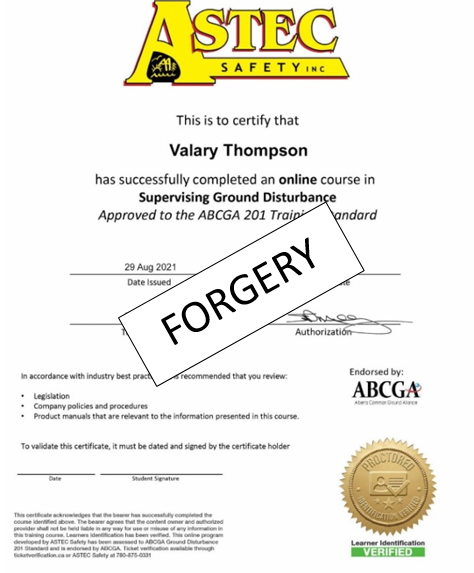Counterfeit Safety Training Certificates...the perfect storm!
Print this Article | Send to Colleague
The aftermath of the COVID-19 Pandemic era, combined with large scale layoffs and low-cost access to capable technology has created the perfect storm this year for a noticeable uptick in the production of counterfeit safety training certificates.
While it has always been a problem that professional training organizations have worked to minimize with safeguards like OCR codes, validation stickers and online ticket verification systems to best protect our workplaces, incidents are on the rise. Recently, Energy Safety Canada reported a large operation in central Alberta that had engaged in illegal activities resulting in the production of several thousand counterfeit certificates. In this instance, the students were often innocent victims of misinformation and the illegal handywork of the criminal purporting to be an “Endorsed” or “Authorized” training provider. The students had paid tuition, attended training to what they believed was an endorsed training program, only to be issued a certificate that when checked to a validation system, would be proven to be counterfeit.
Sure, there are students who seek out fraudsters who will just sell them a forged certificate, or even an authorized/endorsed training provider who will skirt the rules and issue certificates without the student completing all the pre-requisite training and examination(s). The latter of which is extremely hard to discern as a safety officer or employer, as the student certificate may well meet all the security and safeguard standards, perhaps even satisfying the validation criteria. However, more often than not, there are common indicators of fraud or counterfeit certificates if you thoroughly assess and look for the following:
- Inconsistencies in colour, font, variable data fields, and/or dates
- Alterations of any kind
- Poor quality logos, misplaced images, or missing signatures
- Irregular course naming conventions
Training provider on certificate does not provide contact or ticket verification information - No evidence of security measures (i.e., validation stickers, OCR codes, control/cert numbers)

In the example below, the ticket number is invalid and cannot be verified via the online verification system, the ASTEC SAFETY logo is a three-year outdated logo style, the proctoring service partner has no record of this student, and the student named on the certificate does not exist in the student database.

Should an employer or safety person on site encounter any of these scenarios when reviewing a safety training certificate, start by asking the presenter for information about the course, the safety company, and seek contact information to positively determine the validity of the Student Training Certificate. During normal business hours, call the training provider directly. Professional training providers will validate issued certificates if you cannot access the automated system, or have additional questions to ensure the certificate was issued under the right conditions.
With the economic hardships people are encountering and the technology that is available today, plagiarism, illegal copying of materials and the production of counterfeit certificates is an unfortunate reality we face in managing our respective safety programs. Start by ensuring your team members are attending classroom or procuring online training from Utility Safety Partners Endorsed Training Providers. That will be an important first step in avoiding the costs and risks associated with workers presenting counterfeit training certificates in your workplace.
Jeff Mulligan - Chief Operating Officer
jmulligan@astecsafety.com

